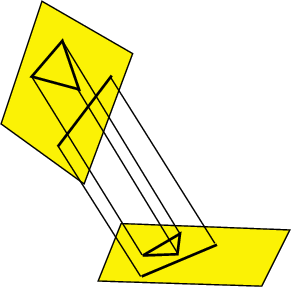|
|
|

A projection is the transformation of Points and Lines in one Plane onto another Plane by connecting corresponding points on the two planes with Parallel lines. This can be visualized as shining a (point) light source (located at infinity) through a translucent sheet of paper and making an image of whatever is drawn on it on a second sheet of paper. The branch of geometry dealing with the properties and invariants of geometric figures under projection is called Projective Geometry.
The projection of a Vector ![]() onto a Vector
onto a Vector ![]() is given by
is given by
See also Map Projection, Point-Plane Distance, Projective Geometry, Reflection
References
Casey, J. ``Theory of Projections.'' Ch. 11 in
A Treatise on the Analytical Geometry of the Point, Line, Circle, and Conic Sections, Containing
an Account of Its Most Recent Extensions, with Numerous Examples, 2nd ed., rev. enl. Dublin: Hodges, Figgis, & Co., pp. 349-367, 1893.
Foley, J. D. and VanDam, A. Fundamentals of Interactive Computer Graphics, 2nd ed. Reading, MA: Addison-Wesley, 1990.